

What is Scrum?
Scrum is an Agile-based project management framework where in-house and virtual teams develop products in short project cycleprins called sprints. At the end of each sprint, you gather customer feedback and incorporate their suggestions before continuing your development process.
With tons of software developers buzzing about Agile Scrum and daily standups, it’s easy to get lost and overwhelmed.
I mean, there are only so many times that you can nod at the water cooler without knowing a thing, right?
But don’t worry.
It’s far easier than it sounds!
In this Scrum guide, we’ll go over everything you need to know about Scrum to help you understand how it can help you and your entire team. We’ll also highlight the best way to manage any Scrum project.
Let’s get started!
What Is Scrum?
Scrum is super simple:
It’s a software development methodology that helps teams, particularly software teams, manage their product development.
How does Scrum work?
In the Scrum method, you follow an incremental and iterative process to project or product management.
The project’s life cycle is split into smaller cycles of specific time periods (called sprints) that you tackle independently. Each sprint has a recommended duration of 2–4 weeks and will help you quickly develop your project and reach your deadlines on time.
After each sprint cycle is complete, you present the working software (called increment) to the stakeholder (usually, customers) for their feedback.
What is working software?
The working product is simply a viable product in usable condition.
After demonstrating the product to the customers and gathering their feedback, you implement their recommendations before moving on to the next sprint.
This is very different from a traditional project management process, like the Waterfall model, where you develop a complete product before shipping it to customers.
Here’s an example:
Say you’re developing a software application.
If you use traditional methods like Waterfall, you will do all the complex work in the software development process (planning, testing, and developing) by yourself for over a year.
You’d then present it to your customers, expecting them to appreciate all the hard work you put in. The problem is, they might not love everything about it.
Remember, you’ve built this app by assuming what they want and need. Those assumptions may not have been accurate.
Instead, if you used Scrum project management, you could’ve actively involved them each step of the way and got their input. This helps you build superior quality products, giving the highest value to your customers!
To keep up with the fast development work pace, Scrum product teams use a whiteboard (Scrum board) to manage their tasks and sprints.
What is Scrum used for?
While Scrum is mostly used by developer teams to manage software projects and build high-quality software, it can also be used by Agile marketing and sales teams to manage projects efficiently.
How does Scrum help?
There are two key benefits of using the Scrum method:
- As you’re not attempting the entire project at once, it’s easier to make changes if something goes wrong. For example, if there’s a technical glitch, you only have to redo one sprint cycle and not the entire thing (PHEW!)
- The sprint-based iterative development allows you to get feedback from the stakeholder at the end of each sprint cycle and helps you incorporate it into your development before the next sprint. With this ongoing process, you’re actively involving the customers and can create a final product that they love!
Remember the phrase: “for the customers, by the customers?”
Scrum ensures that it’s a real thing and not just a marketing gimmick!
A brief history of the Scrum methodology
If you’re familiar with rugby, you’ll know what “scrum” means. It’s a rugby formation where a team puts their heads together and tries to gain a ball’s possession.
And that’s exactly where Scrum project management has its roots.
Here’s a quick history lesson about Scrum:
- In 1986, two Japanese professors, Hirotaka Takeuchi and Ikujiro Nonaka, introduced the term “scrum” in their Harvard Business Review article “The New New Product Development Game”
- Inspired by this, Jeff Sutherland used the Scrum theory for software development projects in the early 1990s
- In 1995, Jeff Sutherland and Ken Schwaber presented Scrum as a proper framework at the OOPSLA ’95 (Object-Oriented Programming, Systems, Languages & Applications ’95) conference
- In 2001, Ken Schwaber, Jeff Sutherland, and 15 others introduced the Agile project management framework and Scrum was defined as an Agile-based project management methodology
But wait, what’s Agile?
The Agile framework is a broad classification of management methodologies that are based on the sprint approach.
While each Agile method is unique, all Agile methods follow the Agile Manifesto.
Is Agile a part of Scrum?
Agile isn’t a part of Scrum; it’s the other way around.
Scrum is a subset of Agile, built on the various Agile management values and principles. It adopts an iterative approach of short duration to product development.
What is the Agile Manifesto?
The Agile Manifesto is a brief summation of the Agile methodology and what it stands for. It consists of 12 key principles that guide Agile development and Agile programming best practices.
You have to diligently follow the Agile principles to ensure that everything goes according to plan. Here’s a summation of those principles:
- Agile principles of customer satisfaction: your customer should always be your priority. Inspect and adapt to changing needs and feedback to deliver a working product that they’re happy with.
- Agile principles of quality: your primary measurement of success is customer satisfaction. This is achieved with test-driven, sustainable development that leads to continuous improvement.
- Agile principles of teamwork: team members should always be actively involved and motivated. Empower your entire team, treat them as capable individuals, and give them the tools they need to succeed.
- Agile principles of project management: keep your test-driven development simple and evaluate your process constantly. Remove all unnecessary processes to speed things up and optimize things regularly.
So what does all of that translate into?
Agile development methodologies inspect and adapt to changing requirements over time and encourage constant feedback from the end-users.
They implement customer feedback at all levels to ensure that the final product is something they won’t stop raving about, which is something you won’t see in the Waterfall model.
Let’s now see how the Scrum method fits in with the Agile framework.
Think of it this way: if Agile is a diet; Scrum is a recipe to facilitate that diet.
Basically, Scrum is a subset of the Agile framework, with Scrum values and Scrum principles building on the Agile principles.
The goal of Scrum is to take the test-driven development principles and make them faster, simpler, and more flexible, helping you develop complex products easily.
And while Agile and Scrum teams are similar, their roles differ slightly.
For example, in an Agile team you could have an Agile coach or project manager, while in a Scrum team, the role of a project manager is usually divided between the product owner, Scrum master role, and development team.
Why is it called Agile Scrum?
Scrum is also known as Agile Scrum since it uses the basic principles of Agile project management philosophy.
In fact, you can combine Scrum with another Agile method like the Kanban method, Extreme Programming, Lean, or Scaled Agile framework for more efficiency.
Who can benefit from Scrum?
Agile methods like Scrum are naturally suited to software development teams.
As software development projects usually involve rigorous customer testing and are highly flexible, Scrum suits them perfectly.

However, Agile software development isn’t the only place where Scrum is used.
Despite its roots in the tech world, Scrum lends itself to any kind of environment.
Anything from a software development team and a marketing team to sales firms and small development organizations with just a few employees can use Scrum.
The Scrum approach doesn’t discriminate; it can help everyone!
What Are Scrum Values?
The Scrum values form the ethical code for Scrum teams and include five everyday values:
- Courage: Scrum teams must have the courage to experiment and do the right thing
- Focus: teams must focus on the sprint and goals at hand
- Commitment: teams must create realistic goals with a clear purpose and commit to achieving these goals
- Openness: everyone involved in the Scrum project must be open about challenges faced and project work performed. This ensures that there’s complete transparency over everything.
- Respect: for effective team collaboration, members must respect each other regardless of their technical skills or backgrounds
Sounds simple, right?
What Are Scrum Artifacts?
Scrum artifacts sound like lost remnants of some abandoned cave that Indiana Jones explored.
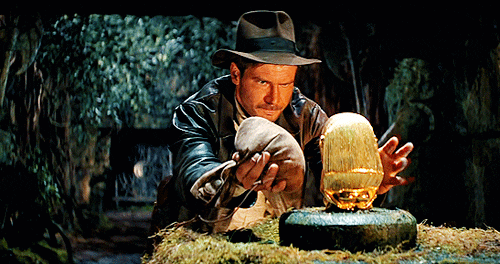
But they’re actually core elements of Scrum.
Each Scrum artifact forms the backbone of your processes to ensure that Scrum works effectively.
Here’s a quick look at the artifacts that shape the Scrum framework.
A. What is a product backlog?
The product backlog is a prioritized list of tasks that must be completed, as well as everything that needs to happen to make a project a reality.
This Scrum artifact is essentially a to-do list of everything that needs to be done to finish a project.
Usually, a product backlog item is presented via user stories to make them easier to apply.
What are user stories?
User stories are a core part of the Agile Scrum methodology.
They’re short descriptions of product features from the perspective of the end-user. In the Agile methodology, the user story takes the form of this simple sentence:
“As a [end user role], I want [the desire] so that [the rationale]”.
The developers then consider that user story as they build and create features in their workflow. This is meant to help product owners and Scrum team members consider the user’s perspective instead of their own. It essentially helps the product team create a shared understanding of what the user really needs.

Does the product backlog change?
As Scrum is such a dynamic project management methodology, no Scrum artifact can remain static. That’s why your product backlog items constantly change as your project progresses.
How does this happen?
As you get frequent feedback after every cycle, you’ll have a better idea of what customers want and need. You can then add or remove a product backlog item to ensure that your final product reflects their requirements accurately. This whole process is known as backlog refinement.
B. What is a sprint backlog?
The sprint backlog is essentially a product backlog, except it only contains items for a particular sprint.
Just like the product backlog, the sprint backlog is extremely flexible as your development team modifies its stories according to the feedback they get.
C. What’s an increment?
No, this isn’t your annual pay raise.
The increment, also known as working software or product increment, is the usable end product from each Scrum sprint.
For example, if a sprint was focused on creating an app feature, that finished feature is termed the sprint’s product increment.
What Are The Key Scrum Roles?
So it’s clear that Scrum is a specialized project management methodology.
But what about the people that run it?
Shouldn’t they be special too?
They are!
While every company and Scrum team is different, they all usually contain three key Scrum roles. These three parties constantly collaborate with each other to ensure that the project meets its deadlines.
Here’s a short overview of the various roles in the Scrum team model.
A. Who is the product owner?
The SCRUM development process starts with the Scrum product owner.
They have a vision for what the final product needs to be. They know the product requirements and make final decisions on what is included or excluded.
The owner is also the person who presents each increment to the stakeholder and relays their feedback to the Scrum team.
It’s essential that there’s only one Scrum product owner in each project and that their authority goes uncontested.
Why?
Well, would you put both Archie and Reggie in charge of the party arrangements?
If you have more than one owner, there’s going to be no clear leadership in place, which will complicate decision-making.
If you have more than one Scrum product owner, you’re going to deal with this:

Fun, right?
And while you can have one product owner for multiple Scrum teams, it’s not really recommended, even if it’s for small projects.
As there’s so much responsibility for the product owner role, it’s also important that they have proper Scrum training. For the right Scrum training and Scrum certification, professional Scrum groups like the Agile Alliance or Scrum Alliance are reliable sources.
B. Who is the Scrum master?
In the Scrum framework, the Scrum master is sorta like a project manager with a cooler name.

They hold the product development together and keep them accountable for their goals and deliverables.
A major function of the Scrum master role is to promote community and harmony within the team. They can also help the product owner with the project’s resource allocation process.
Scrum masters don’t necessarily seek a return on investment (even though ROI is a factor) but try to promote the right practices to streamline the Agile process and create an effective Scrum team.
However, the core roles and duties of a Scrum master vary on a company-by-company basis.
In one Agile organization, the Scrum master might be responsible for part of the product development process itself. In a larger Agile organization, they may simply be a mediator, coaching the team in product development.
As the Scrum master role varies so much from a regular project manager, they can’t instantly manage Scrum teams. It’s recommended that every project manager becomes a certified Scrum master before taking on the role.
They should ideally undergo thorough Scrum training from professional groups, like Scrum.org and Project Management Institute, and get a Scrum certification before managing these projects. That’ll surely make you a great Scrum master.
C. Who is part of the Scrum development team?
The Scrum development team is probably the hardest working team in the world.
Scrum teams are small 5-7 member teams that perform most of the development effort in a project. Scrum team members usually have specialized skills and cross-train their coworkers to ensure that nobody slows down the development process.
These cross-functional teams are also highly self-organizing teams and assist each other to reach their goals with minimal outside assistance.
Due to the level of self-organization needed, Scrum team members need to be thoroughly trained and experienced to carry out their duties. While they’re not forced to get a Scrum certification from a professional Scrum institute, it’s recommended.
What Are The Key Scrum Ceremonies (Events)?
The Scrum framework is based on a sequence of repetitive events (Scrum events) that keep the project on track. They’re vital to a project’s progress and you can’t make do without them.
Here’s a closer look at the Scrum events that guide development.
A. What is the backlog planning meeting?
This is the first Scrum planning meeting.
Here, the product owner starts to build the product backlog to give the team an idea of all the tasks and stories they’re going to handle. As your product backlog constantly changes with new customer feedback, this event never really ends.
You’ll have to constantly make planning adjustments to your product backlog until your product is finished.
B. What is the sprint planning meeting?
Sprint planning is another core part of the Scrum and Agile process.
In the sprint planning meeting, the entire development team decides on the scope (planned work) for an individual iterative cycle.
The team goes over the existing stories in the product backlog and decides on which ones they’ll attempt in the current sprint. The team then decides on the deadlines for this sprint and divides the task responsibilities among themselves.
C. What is a Scrum sprint?
What’s the first thing that comes to mind when you hear sprints? Usain Bolt?
Or maybe the neighborhood kids running at full pace, right?

That’s pretty much what sprints are in the Agile process too!
Also known as time boxes or iterations, sprints are usually two-week periods that encapsulate a project session.
During each fixed-length iteration, your development team:
- Actively works on a product
- Inspects and adapts to customer feedback
- Checks in with each other
While most sprints have a “sprint goal” that consists of a set of deliverables, those goals can be flexible. This is because sprints have to take customer feedback into account and if the customer needs some changes, the Scrum sprint has to accommodate that.
D. What are daily standups?
Daily standups are super-fast, daily Scrum meetings for sprint progress updates on everything about the product backlog. Teams use the daily Scrum meeting to go over what happened and prepare for the upcoming work on a daily basis.
Daily Scrum meetings should:
- Be less than 15 minutes
- Have all team members present
- Be run by the Scrum master who keeps everyone on task
- Be in the morning to reflect on the previous day and set the agenda for the day
Remember, the daily Scrum meeting is not a meeting to resolve project impediments.
Progress impediments that are raised are usually dealt with by the relevant subgroup immediately following the meeting.
During the daily meetings, each team member answers the following three questions as part of the Scrum process:
- What did you do yesterday?
- What will you do today?
- Are there any impediments in your way on the project?
E. What is the Scrum of Scrums meeting?
Scrum of Scrums sounds like the final battle in a fantasy TV series about Scrum management, right?

Sadly, it’s not. It’s sorta like a big daily Scrum meeting.
Sometimes, teams divide themselves into multiple Scrum teams to cope with large project demands. Additionally, if you have a large team size, it’s best to divide them into multiple Scrum teams.
While all these teams work towards the same sprint goal, they work fairly independently.
However, as there are multiple teams engaged, they need to coordinate too, right?
That’s where the Scrum of Scrums meeting comes into play.
Here, representatives of each individual team come together to update everyone on their sprint progress on a regular basis. The Scrum of Scrums ensures that everyone’s on the same page and is clued in about what each Scrum team is doing.
F. What is the sprint review meeting?
Serving as inspection points for the stakeholder, a sprint review meeting is where teams present the increment to the stakeholders for their feedback.
Here, you present a demo of the working software for stakeholder quality check and validation. This way, teams get timely feedback from stakeholders and can make the necessary changes in the upcoming sprint.
G. What is a sprint retrospective?
Conducted at the end of the sprint, the retrospective meeting involves the whole team inspecting the last sprint and discussing how to improve things in the next sprint.
Remember, learning from feedback is a key part of the Agile Scrum methodology and this gives team members fabulous opportunities to learn.
By reflecting on what went wrong in the previous sprint and brainstorming ideas for improving the future sprint, teams use the sprint retrospective to systematically improve over time.
Bonus: Sprint retrospective templates
So how’s a sprint review different from a sprint retrospective?
Both the review and retrospective meetings ensure that there’s frequent inspection but of two different things.
In a sprint review, the focus is on demo-ing and improving the product increment, while in the retrospective, the focus is on process improvement by analyzing previous sprints.
How To Keep The Agile Scrum Methodology Running Smoothly
Sure, Scrum team roles, artifacts, and ceremonies help you build the Scrum framework and develop products with high business value.
But they’re not enough to manage your projects entirely.

Shocked? Don’t be.
If you really want to benefit from Scrum Kanban, Scaled Agile, Extreme Programming, or any Agile method, you need to use the right Agile software.
Why?
Without Agile software, your team isn’t going to have a consolidated place for all their activities. They’re going to have to switch between multiple apps for a rough idea of what’s going on.
(And with any Scrum project, there’s a LOT usually going on!)
Excellent Agile Scrum tools will help an Agile team:
- Track their project or sprint progress
- Keep track of each product backlog item, user story, and their story points
- Collaborate with each other and project stakeholders
But with tons of tools available today, which one do you go for?
Simple: ClickUp!
The Best Agile Scrum Tool For 2021: ClickUp
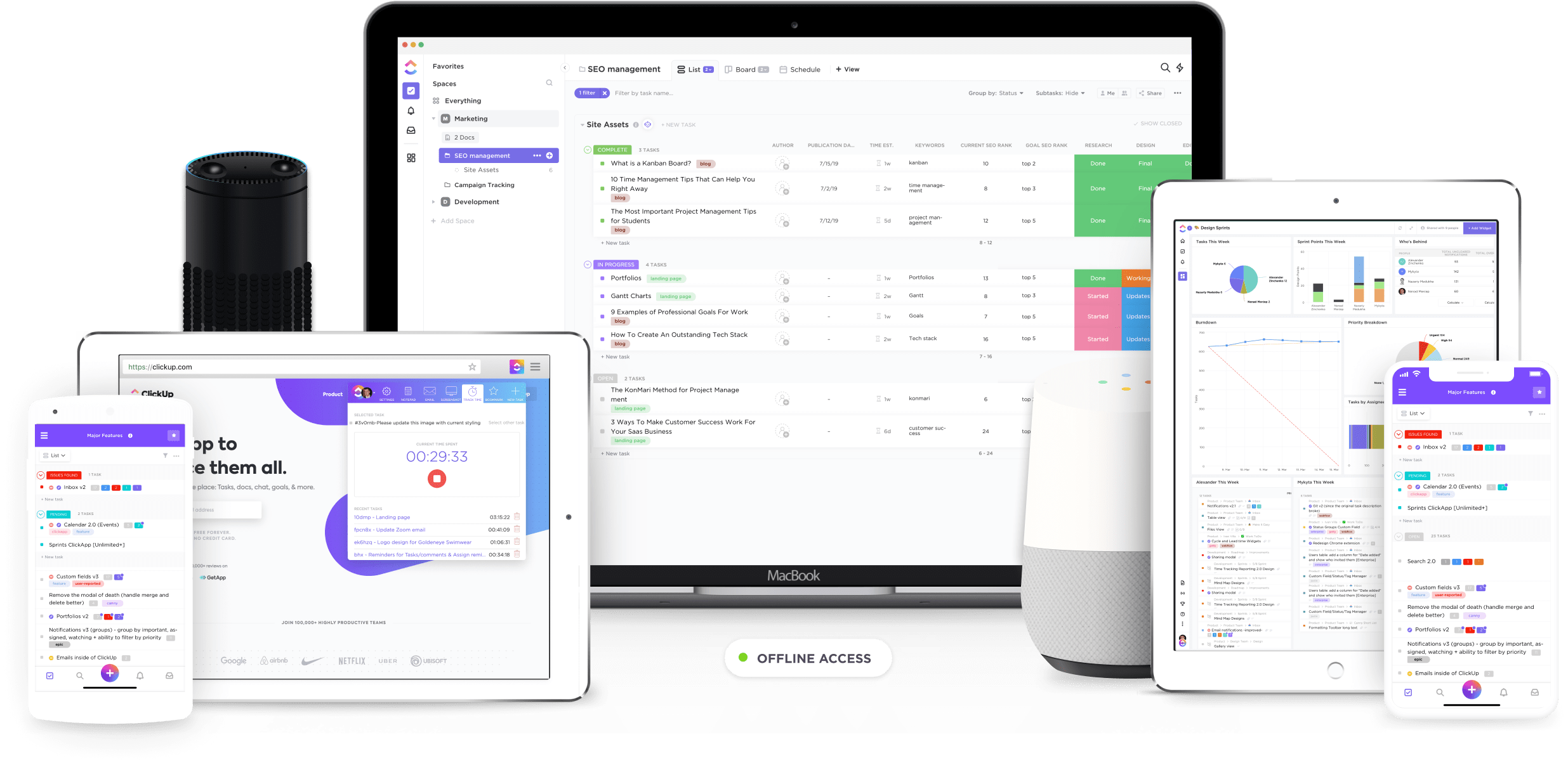
ClickUp is the world’s highest-rated Agile Scrum project management tool.
Used by 200,000+ teams from startups to large companies like Google, and Webflow, it’ll make Scrum and Agile transformation effortless.
Additionally, if you’re looking for the ultimate tool to overcome the key virtual team challenges associated with remote project management, use ClickUp!
ClickUp has tons of features to help you with in-house and remote Agile Scrum projects, like:
- Cope with changing task stages with Multiple Views
- Track what your sprints contain with Sprint Lists
- Monitor task progress with Agile Dashboards
- Keep up with task states with Custom Statuses
- Facilitate instant communication with Assigned Comments
Here’s a quick look at how ClickUp helps with Agile and Scrum development:
1. Multiple Views that help you manage various project requirements
Agile and Scrum are all about adapting to changing customer requirements, right?
That’s why your project management tool should be capable of handling these changing needs too.
Instead of using a rigid management tool that forces your Agile team to adapt to its interface, use ClickUp!
It gives you Multiple Views to instantly adapt to the Scrum and Agile approach.
Here’s a detailed look at these views and how they help any Scrum or Agile team:
A. Required Task Views
ClickUp has two required task views to handle two common project management styles:
- List view
This view is perfect for Scrum teams who manage their work with GTD-style to-do lists. As tasks are listed down as a simple checklist, you can easily check them off as you progress.
Use it to keep track of your sprint lists for multiple tasks. As each task is listed one after the other like an ordered list, you can tackle each one sequentially.
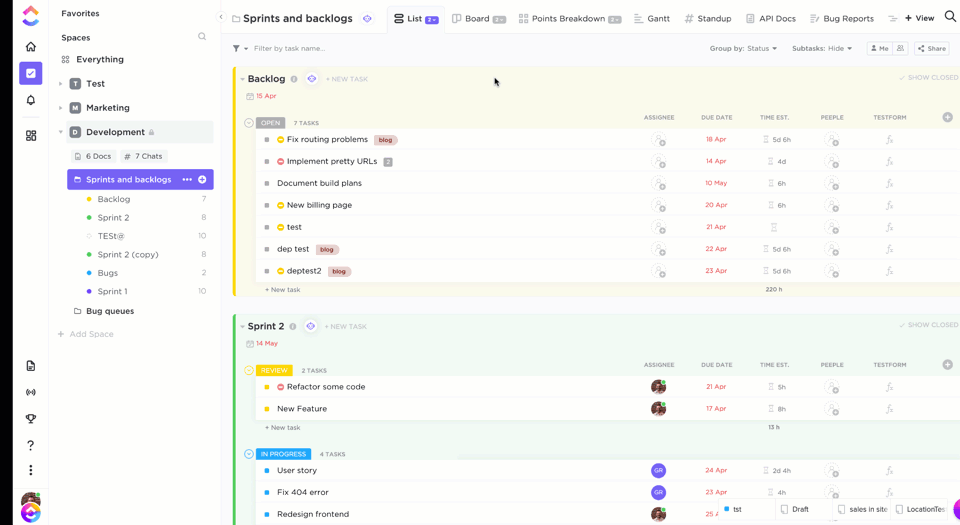
- Board view
The Scrum board view is perfect for teams who like to combine Scrum and Kanban methods. You can even use this view if you simply want some Kanban board functionality in your Scrum board!
Here, your tasks are laid out on a Scrum task board where you can drag and drop them to make quick adjustments.
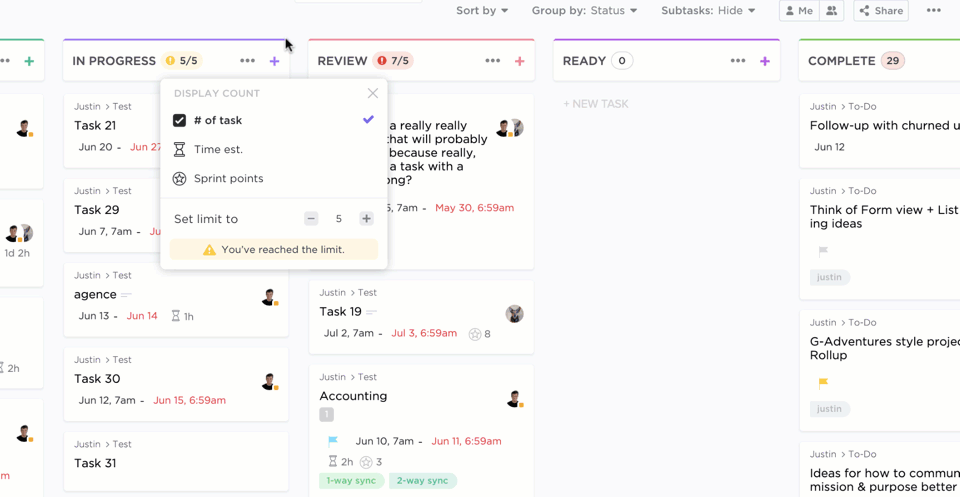
B. Box view
The Box view is perfect for high-level overviews of what your team is up to.
The project owner and product manager can use this view to keep a check on the development team. As tasks are sorted by assignee, you’ll instantly know who’s working on what.

C. Calendar view
ClickUp’s Calendar view helps you plan and manage your sprint tasks in advance. Use it to also decide when you can add items from your product backlog to your sprint backlog.
For added flexibility, managers can view their calendar as:
- Days: view all the tasks scheduled for a given date and do a daily productivity review
- 4-Days: look at your task schedule over a rolling four day period
- Week: view your weekly sprint schedule
- Monthly: shows your project roadmap on a monthly basis

D. Me Mode
ClickUp’s Me Mode is the perfect way to only keep track of what’s been assigned to you.
It only highlights tasks, comments, and lists that are assigned to you. This way, you can easily focus on your tasks without getting distracted by other team members’ assignments.

2. Sprint Lists to always keep track of your sprints
The Scrum and Agile approaches revolve around sprints.
Ask any Scrum master, and that’s all you’ll hear them talking about.

But as sprints are so essential to Scrum, your project management tool needs to be able to handle them effectively.
ClickUp lets you create Sprint Lists that break down the deliverables for each sprint. As these are checklists, you can quickly check items off as you progress through the current sprint.
You can even add Scrum points to these lists to determine how long it’ll take to finish your Scrum backlog.

As this is so easy to read and use, an Agile coach can easily use it to train new teams on the various Agile practices.
3. Agile Dashboards for detailed visual overviews of projects
There’s nothing like actually seeing your project progress, right?
I mean, it’s far better than just looking at some numbers instead.
To help you with that, ClickUp comes with powerful Dashboards. They’ll give you quick, detailed overviews of your project progress.
Here’s a look at how these Dashboards help you tackle the Agile approach to project management:
A. Velocity Charts
ClickUp’s Velocity Chart helps you determine the completion rate of your tasks.
All tasks are broken down into bi-weekly or weekly intervals, and their average velocity is displayed in the graph. ClickUp also automatically groups sprint list data to make it easier to add. This helps you identify how quickly you’re breezing through your Scrum backlog.

B. Burndown Charts
ClickUp’s Release Burndown Chart highlights how your team is performing against a target line. It also shows you the amount of work that’s left to be completed.
The release burndown chart highlights various metrics like:
- Target progress: shows the ideal task completion pace to reach your sprint goal
- Projected progress: displays your team’s current progress rate based on completed tasks
- Active: shows the current number of completed tasks

As a release burndown chart helps you identify if you’re behind schedule or not, Scrum teams use them to identify progress impediments quickly.
C. Burnup Charts
Unlike a sprint burndown chart, burnup charts show you how much work you’ve already completed against the total work involved. This way, you can take stock of what you’ve finished and motivate your team to finish well.

D. Cumulative Flow Charts
ClickUp’s Cumulative Flow Charts show how your tasks progress over time.
Your tasks are broken into different colors based on their current status. This helps you quickly identify bottlenecks and step in to resolve them.
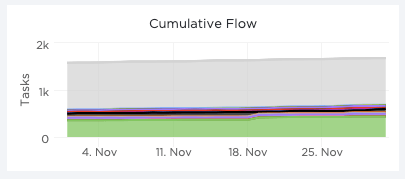
4. Custom Statuses to help manage varying task stages
Remember, the Scrum or Agile methodology isn’t only for software development teams.
It’s also used by multiple teams like sales teams and marketing professionals.
And while the basic Scrum process framework remains constant, each team will have its own specific needs and project phases.
For example, the review processes for Agile software development and Agile marketing project are going to be very different.
That’s why you need a tool that can create tailor-made statuses for each of your projects.
ClickUp’s Custom Statuses feature lets you customize project statuses on a case-by-case basis to suit your requirements. This way, you’re not stuck with a rigid set of statuses that aren’t relevant to your needs.

5. Assigned Comments to keep your projects moving along
One of the key benefits of the Scrum process is quick turnaround times.
But you can’t achieve that if your members take forever to respond to your comments, right?

With ClickUp’s Assigned Comments feature, you can say goodbye to this problem!
ClickUp lets you quickly create tasks out of comments and assign them to any team member. It’ll then notify them about these comments, and they’ll even pop up in the comments and mentions sections of their Home tab in their Inbox.
Once the task is complete, they can mark the comment as resolved to avoid needless follow-ups!
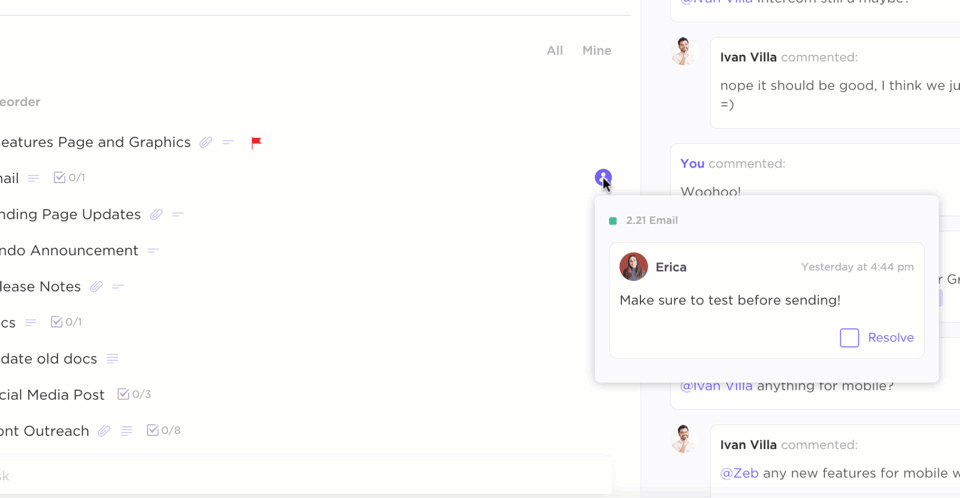
However, those aren’t all of ClickUp’s features.
To aid Agile transformation, this effective tool gives loads of additional features to cope with Agile development and Scrum principles:
- Priorities: set a priority order for your sprint tasks based on the highest priority
- Automation: automate 50+ tasks within ClickUp to save time
- Pulse: visualize your team’s activity using a real-time status report with an excellent level of detail
- Workload view: team leaders can ensure that each member only tackles an appropriate amount of work based on their capacity
- Goals: split your sprint or product goals into smaller, crystal clear Targets
- Subtasks and Checklists: break down complex tasks or work items into simpler tasks or to do lists
- Mind Maps: create free form Mind Maps to simplify the sprint planning process
- Gantt Charts: chart your project’s progress easily with beautiful Gantt charts
- Dependencies: quickly tackle your Agile software development tasks in the right order
- Detailed Reporting: analyze team performance with detailed work reports during the sprint review, sprint retrospective, or sprint planning meeting
- Custom Access Rights: allow clients and stakeholders into your project space for better collaboration without compromising your privacy
- Templates: Use ClickUp’s agile templates for your next project
- Powerful iOS and Android mobile apps: monitor your work on the move
Conclusion
So what is Scrum?
We hope this Scrum guide helped you answer that.
But we’ll briefly go over it again anyway:
Scrum is a subset of Agile project management that’ll help you incorporate customer feedback and deliver great end products quickly.
And from Scrum principles to the Scrum backlog and sprint planning meeting, there’s a lot going into Scrum.
Luckily, you can easily manage Scrum or Agile project management with the right Scrum software.
So why not sign up for ClickUp today?
Perfect for any team size, ClickUp has everything you need to manage your backlog, sprints, and team members, all with the highest level of user-friendliness!



Join the conversation
Comments for this post are currently closed.
We used to use more of a GTD method, however, Agile has seemed to work so much better for my team! Thanks for the tips!
Questions? Comments? Visit our Help Center for support.